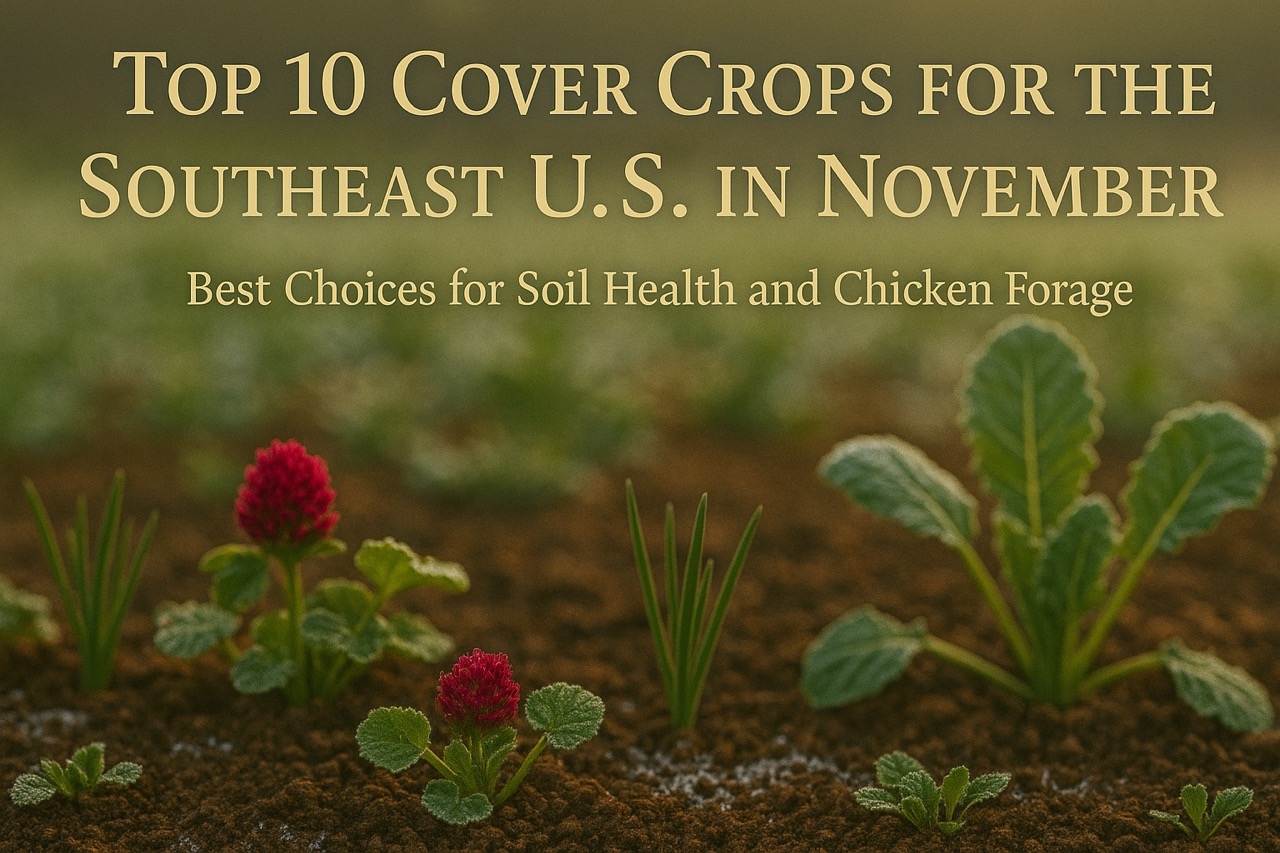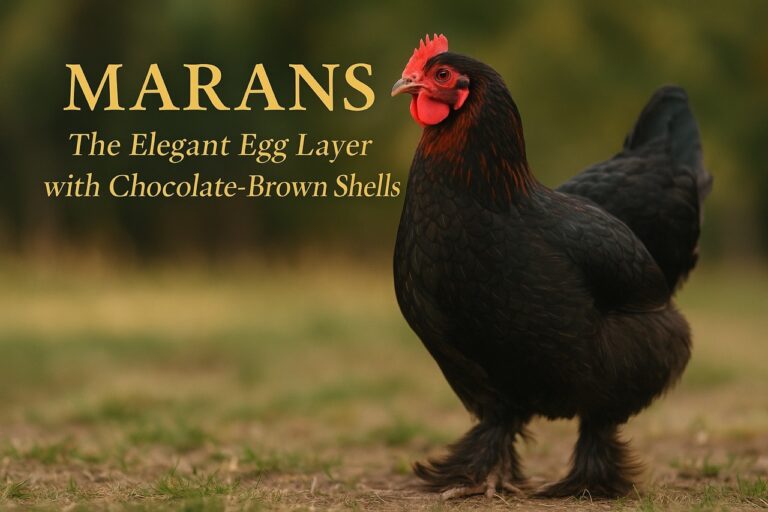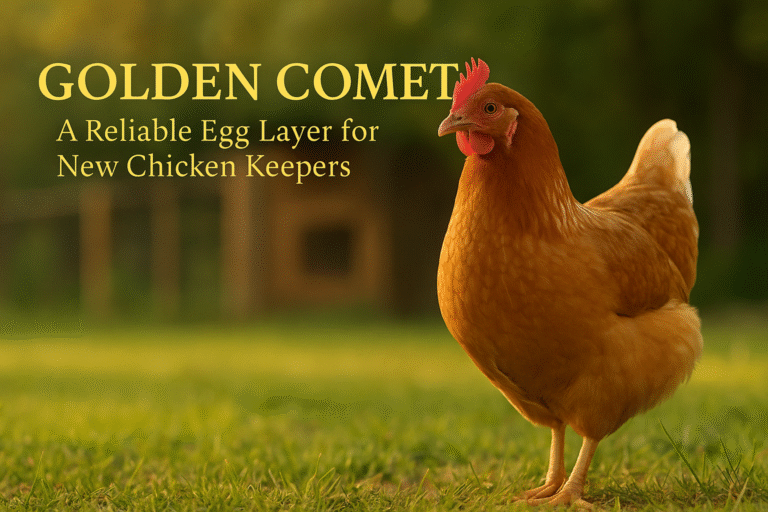Planting cover crops in November is one of the smartest moves Southeastern gardeners and backyard chicken keepers can make. These crops aren’t just placeholders — they actively build soil, reduce erosion, suppress weeds, and even feed your flock.
In the Southeast’s mild winters, these ten cover crops thrive when planted late in the year. They’re ranked here by their cold resilience, soil-improving traits, and their value as nutritious forage for chickens.
🌾 1. Winter Rye (Cereal Rye)
Best For: Weed suppression, erosion control, and soil structure
- Rapid germination and deep roots
- Excellent cold tolerance for Southeastern winters
- Smothers winter weeds and anchors loose soil
🐔 Chicken Benefit: Chickens enjoy nibbling on rye leaves, which regrow after moderate grazing.
🌱 2. Winter Wheat
Best For: Soil stabilization and organic matter
- Builds strong root systems to hold soil
- Adds biomass for spring till-in
- Great for no-till systems
🐔 Chicken Benefit: Provides steady, hardy greens for winter foraging flocks.
🍀 3. Crimson Clover
Best For: Nitrogen fixation and soil fertility
- A legume that naturally adds nitrogen to your soil
- Produces beautiful red blooms in early spring
- Helps shade out unwanted weeds
🐔 Chicken Benefit: Chickens love clover — and grazing it doesn’t hurt its soil benefits.
🌿 4. Austrian Winter Peas
Best For: High-protein forage and nitrogen cycling
- Tender leaves and vines that chickens love
- Fixes nitrogen to enrich soil before spring planting
- Decomposes easily after tilling
🐔 Chicken Benefit: One of the most nutrient-dense forage options for your flock.
🥕 5. Daikon Radish (Tillage Radish)
Best For: Deep soil aeration and compaction relief
- Long taproots break up hardpan soil layers
- Improves water flow and spring root depth
- Adds organic matter when roots decompose
🐔 Chicken Benefit: Chickens usually ignore the root but will enjoy the leafy greens.
🪴 6. Hairy Vetch
Best For: Nitrogen fixation and ground coverage
- Sprawling vine with strong weed suppression
- Fixes nitrogen like clover and peas
- Protects soil from erosion during winter rains
🐔 Chicken Benefit: Withstands light scratching and occasional grazing.
🌾 7. Annual Ryegrass
Best For: Quick soil cover and weed control
- Grows fast and thick
- Holds soil in place on slopes or tilled ground
- Regrows after trimming or pecking
🐔 Chicken Benefit: Ryegrass is flock-approved and recovers well from grazing.
🌾 8. Oats
Best For: Soil conditioning and organic matter
- Cool-season grass that thrives in fall plantings
- Builds root mass that adds structure to sandy soils
- Dies back with frost, adding mulch layer
🐔 Chicken Benefit: Soft, palatable greens that chickens love — just limit early grazing until established.
🌸 9. Buckwheat (Fall-Only)
Best For: Quick pre-winter cover and weed suppression
- Germinates in days
- Excellent for choking out fall weeds
- Adds organic matter fast before frost
🐔 Chicken Benefit: Chickens enjoy buckwheat greens, but it won’t survive winter — consider it a fall treat.
🌿 10. Mustard Greens
Best For: Biofumigation and pest suppression
- Adds organic matter
- Naturally suppresses soil-borne pathogens
- Enhances soil texture with decomposing greens
🐔 Chicken Benefit: A flavorful favorite in moderation. Overeating may upset digestion — rotate wisely.
🧠 How to Choose and Use Cover Crops Wisely
🛠 Choose Based on Your Goals:
- For soil fertility: Use legumes like crimson clover or Austrian peas
- For structure: Add daikon radish or rye
- For chicken forage: Pick regrowing crops like ryegrass, wheat, and clover
- For quick fall impact: Use oats or buckwheat before frost
🌱 Planting Tips:
- Mix 2–3 crops for resilience and complementary benefits
- Reduce each seed’s rate by 20–25% in mixes to avoid overcrowding
- Rake in after broadcasting and cover with light mulch for protection
🚧 Protect From Chickens Early On:
- Fence off fresh seed beds or cover with straw
- Allow for grazing only after seedlings are well established
🔁 Rotate & Recycle:
- Allow cover crops to grow through winter
- Till or mow 2–3 weeks before spring planting
- Let reseeding crops bloom for low-maintenance future coverage
✅ Conclusion
Planting winter cover crops in the Southeast is a win for both your soil and your chickens. By selecting the right species—and protecting them at key stages—you can grow healthier spring gardens while offering natural forage to your flock.
From deep-tilling radishes to nitrogen-boosting clover, these ten crops provide everything your backyard ecosystem needs to thrive.
📚 Further Reading on Paranoid Prophet
- 🌾 Winter Cover Crops for Chickens
- 🧠 Backyard Chickens & Mental Health
- 🐓 How Many Chickens Should You Start With?
- 🥬 Wheatgrass & Winter Nutrition
Sources
Implementing cover crops in the Southeastern U.S. enhances soil health, prevents erosion, and provides forage for backyard chickens. The following resources offer valuable insights into selecting and managing suitable cover crops for this region:
- Texas A&M Researchers Identify Ideal Cover Crop Species for Southeast Texas
This article discusses research on cover crops like cereal rye and crimson clover, highlighting their benefits in increasing soil organic matter, recycling nutrients, preventing erosion, and suppressing weeds in Southeastern climates. - Best Regional Cover Crops in the U.S. – AgAmerica
This resource outlines optimal cover crops for the Southeast, emphasizing the importance of selecting species resilient to warm temperatures and humid conditions, such as cool-season legumes like hairy vetch and Caley pea. - Cover Crop Options for Hot and Humid Areas
This publication provides guidance on selecting cover crops suited for hot and humid regions, including the Southeast, and discusses management practices to maximize their benefits for soil health and forage. - Cover Crops for Alabama – Alabama Cooperative Extension System
This guide offers insights into cover crops beneficial for Alabama’s climate, detailing species that improve soil quality and provide forage, along with best practices for their implementation.These resources provide comprehensive information on selecting and managing cover crops in the Southeastern U.S., benefiting both soil health and backyard chicken foraging.
FAQ: Top Cover Crops for the Southeast U.S.
Understanding Cover Crops
1. What are cover crops, and why are they important?
Cover crops are plants grown primarily to improve soil health rather than for harvest. They prevent erosion, enrich soil nutrients, suppress weeds, and enhance water retention.
2. Are cover crops beneficial for chickens?
Yes, many cover crops like clover, rye, and peas double as forage for chickens, providing supplemental nutrition while improving the soil in which they grow.
3. Why are cover crops important in the Southeastern U.S.?
The Southeast’s warm, humid climate and nutrient-depleted soils make cover crops valuable for managing erosion, replenishing organic matter, and improving overall soil fertility.
Choosing the Right Cover Crops
4. What are the best cover crops for the Southeast?
- Winter Rye: Prevents erosion and suppresses weeds.
- Crimson Clover: Fixes nitrogen and provides forage for chickens.
- Austrian Winter Peas: Adds nitrogen to soil and offers high-protein greens.
- Daikon Radish: Aerates compacted soil with its deep taproots.
- Sorghum-Sudangrass: Grows quickly and adds organic matter.
5. How do I select the right mix of cover crops?
Consider your goals. For soil improvement, mix nitrogen-fixing legumes like clover with grasses like rye. For chicken forage, add crops like peas and sorghum that provide edible greens.
6. Are there cover crops that work year-round in the Southeast?
Yes, some crops like crimson clover and annual ryegrass can thrive throughout the cooler seasons and reseed for future growth.
Planting and Managing Cover Crops
7. When should I plant cover crops in the Southeast?
For winter cover crops, plant in late fall (October to November) to allow establishment before the coldest months. For warm-season crops, plant in late spring or early summer.
8. How do I plant cover crops?
Broadcast seeds over prepared soil, rake lightly to cover them, and ensure proper moisture levels for germination.
9. Can cover crops be planted in a chicken forage area?
Yes, but protect young crops with fencing or mulch to prevent chickens from scratching them up before they establish.
Benefits and Maintenance
10. How do cover crops improve soil?
They fix nitrogen, increase organic matter, break up compacted soil, and suppress weeds, creating a more fertile and manageable growing environment.
11. How do I maintain cover crops while allowing chickens to forage?
Use rotational grazing to prevent overgrazing. Divide the area into sections and allow crops to recover between grazing sessions.
12. When should I till or mow down cover crops?
Till or mow cover crops into the soil two to three weeks before planting new crops to allow time for decomposition.
Additional Considerations
13. Are cover crops cost-effective?
Yes, they reduce the need for synthetic fertilizers, improve long-term soil health, and can serve as free-range chicken forage, offering significant cost savings.
14. Can cover crops replace chicken feed?
No, cover crops are a supplement to a balanced diet. Chickens still require formulated feed to meet all their nutritional needs.
15. Do cover crops attract pests?
When managed properly, cover crops can deter pests by breaking pest life cycles and attracting beneficial insects. However, some crops like brassicas may harbor pests if left unmanaged.




